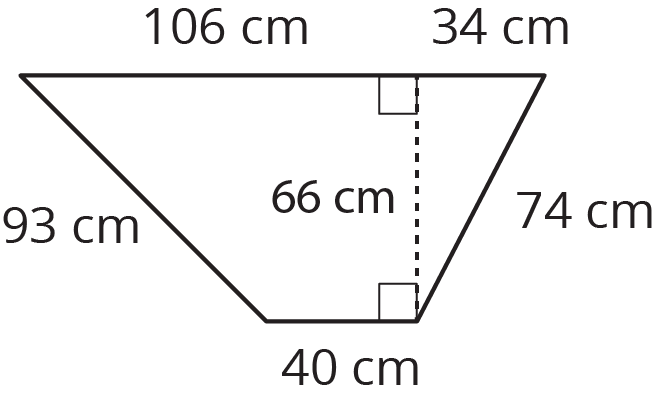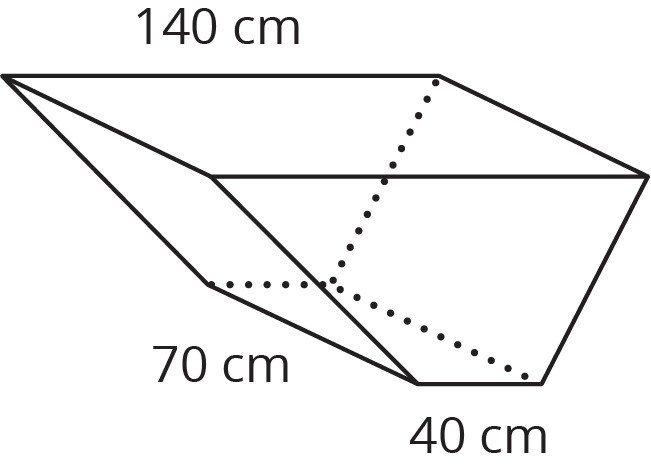Lesson 15
Distinguishing Volume and Surface Area
15.1: The Science Fair (5 minutes)
Warm-up
The purpose of this warm-up is for students to reason about two objects that have the same volume but different surface areas within a context.
Launch
Give students 1 minute of quiet think time followed by a whole-class discussion.
Student Facing
Mai’s science teacher told her that when there is more ice touching the water in a glass, the ice melts faster. She wants to test this statement so she designs her science fair project to determine if crushed ice or ice cubes will melt faster in a drink.
She begins with two cups of warm water. In one cup, she puts a cube of ice. In a second cup, she puts crushed ice with the same volume as the cube. What is your hypothesis? Will the ice cube or crushed ice melt faster, or will they melt at the same rate? Explain your reasoning.
Student Response
For access, consult one of our IM Certified Partners.
Activity Synthesis
Poll the students on their hypotheses. Record and display their responses for all to see. If all students agree the crushed ice will melt the fastest, ask them to share their reasoning. If there are different hypotheses, ask students to explain their choice and ask questions of one another. Continue the discussion until the students reach an agreement on the crushed ice. Important ideas to highlight during the discussion are:
- Since the crushed ice has more places touching the warm water, it should melt faster.
- The center of the cube is surrounded by cold ice and will not melt until it is touching the water.
- The surface area of the crushed ice is greater, so it will melt faster than the ice cube even though they have the same volume.
If any of these ideas are not mentioned by students, bring them to their attention at the end of the discussion.
15.2: Revisiting the Box of Chocolates (10 minutes)
Activity
In this activity students are presented with a prism that was used in a previous lesson to calculate volume. Here, they calculate the surface area of the prism. This provides students with the opportunity to work with complex shapes to find surface area in a given context.
Launch
Display the image for all to see throughout the activity. Tell students that they calculated the volume of this heart-shaped box in a previous lesson and today they are going to calculate a different measurement. Ask students what additional information they need to find the total amount of cardboard in the box. When students recognize that they need the lengths of the diagonal sides of the box give them the measurements for those sides (2.2 inches for the sides around the top and 6.4 inches for the sides around the bottom). Give students 2–3 minutes of quiet work time followed by a whole-class discussion.

Supports accessibility for: Memory; Conceptual processing
Student Facing
The other day, you calculated the volume of this heart-shaped box of chocolates.

The depth of the box is 2 inches. How much cardboard is needed to create the box?
Student Response
For access, consult one of our IM Certified Partners.
Anticipated Misconceptions
Students who are familiar with actual heart-shaped boxes of chocolate may want to double the lateral area to represent the way the top and bottom pieces nest together.
Activity Synthesis
Select students to share their solutions and methods for calculating the surface area. Consider asking some of the following questions:
- “How did you figure out that you had to calculate the surface area of the box?”
- “What method did you use to calculate the surface area?”
- “If the candy maker wants to make a set of two boxes that are each half of a heart and could be put together to make a box that looks like this one, would the total amount of cardboard used to make the two boxes be different than making the one box?” (Yes, it would increase.)
- “How could the candy maker reduce the surface area of the one box without reducing the volume?” (If he made it a triangle or some other shape with fewer segments instead of a heart.)
Design Principle(s): Cultivate conversation; Maximize meta-awareness
15.3: Card Sort: Surface Area or Volume (15 minutes)
Activity
The purpose of this activity is for students to sort cards with questions that have a context referring to either volume or surface area of a prism. In previous lessons, students focused on determining volume or surface area and the two concepts were never presented side by side. Here, students are asked to sort questions with a context to determine if it makes more sense to think about surface area or volume when answering the question. After sorting, students think about what information they need to answer a question and estimate reasonable measurements to calculate the answer to their question (MP2).
Launch
Arrange students in groups of 2. Distribute pre-printed slips, cut from copies of the blackline master. Give groups 2–3 minutes of quiet work time. Once each group has sorted their cards, poll the class as to where they placed each card. Display the answers for all to see for the rest of the activity. Ask students to come to agreement on any differences.
After the class has come to agreement on the sorted cards, students can either choose one card or be assigned a specific card to examine further. Give students 2–3 minutes of quiet work time to complete the rest of the task followed by time to discuss their work with a partner. Follow with a whole-class discussion.
Supports accessibility for: Language; Social-emotional skills
Student Facing
Your teacher will give you cards with different figures and questions on them.
- Sort the cards into two groups based on whether it would make more sense to think about the surface area or the volume of the figure when answering the question. Pause here so your teacher can review your work.
- Your teacher will assign you a card to examine more closely. What additional information would you need to be able to answer the question on your card?
- Estimate reasonable measurements for the figure on your card.
-
Use your estimated measurements to calculate the answer to the question.
Student Response
For access, consult one of our IM Certified Partners.
Student Facing
Are you ready for more?
A cake is shaped like a square prism. The top is 20 centimeters on each side, and the cake is 10 centimeters tall. It has frosting on the sides and on the top, and a single candle on the top at the exact center of the square. You have a knife and a 20-centimeter ruler.
- Find a way to cut the cake into 4 fair portions, so that all 4 portions have the same amount of cake and frosting.
- Find another way to cut the cake into 4 fair portions.
- Find a way to cut the cake into 5 fair portions.
Student Response
For access, consult one of our IM Certified Partners.
Activity Synthesis
Select students to share their explanations of how they determined if a question reference volume or surface area. To highlight the differences and similarities ask students:
- “How do you know volume is being asked about in that question?”
- “How do you know surface area is being asked about in that question?”
The goal is to ensure students can verbally describe their reasoning because they are asked to write about the similarities and differences in the cool down. You may wish to refer back to the poll responses collected in the middle of the activity.
Invite students to share the measurements they came up with and how they calculated an answer to their question. Ask other students who had the same question but used different measurements to share and compare the reasonableness of each answer.
Consider asking some of the following questions:
- “How did you determine which information you needed to answer the question? What information might not be needed?”
- “How did you decide on the exact measurements to use?”
- “What is different about the measurements used in these questions?”
- “Do they all make sense?”
- “Are there other measurements that could have been used?”
Design Principle(s): Maximize meta-awareness; Support sense-making
15.4: A Wheelbarrow of Concrete (5 minutes)
Optional activity
This optional activity reinforces work students have done in previous activities with regards to surface area and volume. Students work with a contextual problem to determine the surface area and volume of an object.
Launch
Arrange students in groups of 2. If desired, display the image of a wheelbarrow for all to see.

Give students 1–2 minutes of quiet work time followed by time to discuss their answers with their partner. Follow with a whole-class discussion.
Student Facing
A wheelbarrow is being used to carry wet concrete. Here are its dimensions.


- What volume of concrete would it take to fill the tray?
-
After dumping the wet concrete, you notice that a thin film is left on the inside of the tray. What is the area of the concrete coating the tray? (Remember, there is no top.)
Student Response
For access, consult one of our IM Certified Partners.
Activity Synthesis
Reveal the solution to each problem and give students a few minutes to resolve any discrepancies with their partners.
Design Principle(s): Optimize output (for explanation); Cultivate conversation
Lesson Synthesis
Lesson Synthesis
- “When is it better to know surface area than volume?” (When you are covering an object, when you want to know how much is exposed to the environment, etc.)
- “When is it better to know volume than surface area?” (When you are filling up the object, when you need to know how much is already inside, etc.)
- “If you cut an object in half, how does that affect the volume and surface area?” (The volume remains unchanged, but the surface area will increase.)
15.5: Cool-down - Surface Area Differences (5 minutes)
Cool-Down
For access, consult one of our IM Certified Partners.
Student Lesson Summary
Student Facing
Sometimes we need to find the volume of a prism, and sometimes we need to find the surface area.
Here are some examples of quantities related to volume:
- How much water a container can hold
- How much material it took to build a solid object
Volume is measured in cubic units, like in3 or m3.
Here are some examples of quantities related to surface area:
- How much fabric is needed to cover a surface
- How much of an object needs to be painted
Surface area is measured in square units, like in2 or m2.